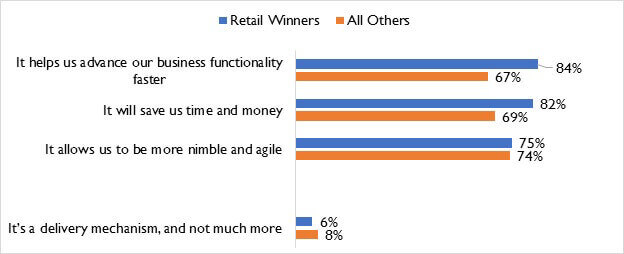Now The Focus Is On Fast-Moving-Consumer-Goods Retailers
Since the introduction of the Amazon Go! store in December 2016 and Amazon’s acquisition of Whole Foods in the summer of 2017, we at RSR have been getting a lot of questions about Fast-Moving-Consumer-Goods (FMCG) retailers – that’s the retail vertical occupied mostly by grocery, drug stores, and convenience stores. That’s interesting all by itself: that one vertical is famously hard to deal with. As I said in my October coverage of the Symphony RetailAI Xcelerate 2018 conference: “Saying that FMCG … is a brutal business is an understatement. Technology companies know that the one thing that FMCG … retailers do better than anyone else is ‚Äòbuy smart’ – they are tough negotiators and will squeeze every last penny out of a deal that they can… So, selling to those retailers is not for the faint of heart. “
FMCG retailers are particularly risk averse when it comes to spending on technology. For example, in RSR’s recent study on the state of Innovation in Retail, we learned that FMCG, whose profit margins are among the narrowest in the entire industry, has been the single most conservative vertical when it comes to experimentation (Figure 1). While this is understandable on one level, it also underlines just how hard it is for those retailers to overcome a cultural bias towards caution and to face disruptive competitive forces proactively.
Figure 1: Famously Risk-Averse

But that attitude is starting to change. In the above-mentioned study, 69% of FMCG retailers indicated their Boards of Directors now “demand ” more innovation. Amazon’s ability to generate fear in boardrooms and operating committees across the FMCG landscape was demonstrated the day it announced it was buying Whole Foods Market. Bearing in mind that Whole Foods was holding only 1.2% share of the grocery industry in the US at the time the purchase was announced, major grocery chains’ stock plummeted around the world.
Such is the impact of the fear of Amazon. Now food and drug retailers have suddenly gotten religion about technology. As the saying goes, “when the going gets tough… “. And there aren’t too many retailers as tough as FMCG merchants!
As a result, RSR is getting asked, “what are FMCG retailers’ top concerns? ” That prompted me to go through the last year of RSR benchmark data to cull the top business challenges that FMCG retailers identify. I looked at responses to surveys for the following studies:
- Retail Needs A Better Workforce: What Will It Take? (December 2017)
- Merchandising And Pricing 2018: Life After The Merchant Prince (April 2018)
- The State Of Online Commerce 2018: High Hopes (July 2018)
- The Retail Store 2018: From Apocalypse To Renaissance (August 2018)
- 2018 Ramping Up Retail Innovation (September 2018)
- Customers Use IoT, Why Can’t Retailers? (October 2018)
We also will have a report forthcoming on the Retail Supply Chain (to be published later this month).
RSR encourages you to read our reports or the shorthand eBook versions – they are free to everyone! But as a service to all those who are eyeing the Fast-Moving-Consumer-Goods vertical as the next opportunity, here and without comment are the top Business Challenges those retailers are dealing with. This list is an aggregation of FMCG retailers’ stated top three Business Challenges from each of the above-mentioned studies, de-duped and highest score on top:
- Aggressive competitors of like items make price our primary demand driver
- There is increased consumer price sensitivity
- Online competitors innovate too quickly for us to keep up
- Retail is not designed to support a long-term, skilled employment structure
- It’s hard to find good, loyal employees
- Differentiating ourselves from our competition
- Need for more consistent store execution/employee productivity
- Consumers expect more self-service in a customer experience
- Consumer behavioral shifts are difficult to keep up with
- Competitors are undermining the profitability of our business
- Out of stocks remain a persistent problem
- Promotional reliance leading to brand equity erosion
- Pressure to grow our business faster
- Pressure to cut our operational costs
This list isn’t RSR’s point of view – this is what retailer leaders in the FMCG vertical have told us. Hopefully it helps answer the question, “what is keeping retail executives up at night? ” Now it’s the technology world’s turn: how are you going to help FMCG retailers address these challenges in ways that create new opportunities for them?
We’ll be watching and listening!
